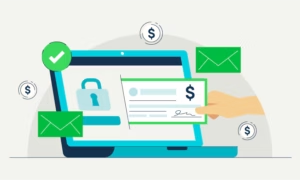Electronic checks, often referred to as e-Checks, are a digital payment method that has gained popularity among businesses, particularly small enterprises. They offer a convenient and cost-effective way to handle transactions. This article explains how e-Checks work, how they differ from traditional paper checks and ACH payments, and why they can be a valuable payment option for your business.
- Understanding e-Checks: The Digital Evolution of Traditional Checks
An e-Check is essentially a digital version of a paper check. It contains the same crucial information: the payer’s checking account number, bank routing number, and the payment amount. What sets e-Checks apart is that the entire transaction process is managed digitally. In the United States, e-Checks operate within the Automated Clearing House (ACH) network, overseen by the National Automated Clearing House Association (NACHA).
Here’s a key distinction: e-Checks are a type of direct debit. Unlike direct deposits, which are “push” payments initiated by the payer, e-Checks are “pull” payments initiated by the payee (the seller). This means that the business receiving payment is in control of the transaction, “pulling” the funds from the customer’s account. This makes e-Checks an excellent choice for collecting payments, especially for high-value items and recurring expenses like rent.
- Why Businesses Benefit from Accepting e-Checks
Businesses often find e-Checks attractive due to their cost-effectiveness. Unlike credit card payments, e-Checks don’t entail expensive processing fees, making them a preferred option for high-cost transactions. Additionally, e-Checks are commonly used for recurring payments, such as subscription fees or membership dues.
When setting up e-Checks for recurring payments, customers only need to provide authorization once during the initial setup. This streamlines the payment process and makes e-Checks an ideal method for businesses that regularly collect payments through subscriptions or membership fees.
- How e-Checks Are Processed
Now, let’s explore the steps involved in processing an e-Check payment:
Step 1: Request Authorization from Your Customer: Before initiating an e-Check payment, you must obtain authorization from your customer. This authorization can be secured through various means, including:
- An authorization form
- A signed contract
- An online order form
- Acceptance of terms and conditions on a website
If necessary, you can also request authorization over the phone, provided the call is recorded to maintain a record of consent.
Step 2: Capture the Customer’s Payment Details: To process the payment, you’ll need to collect essential information from the customer. This information mirrors what would typically appear on a paper check and includes details such as their company name, bank account number, bank routing information, and the payment amount. If the payment is recurring, you’ll also gather information about the payment schedule at this stage.
Step 3: Payment Processor Receives Payment Details and Initiates Payment: Once you’ve gathered the necessary information, you will provide it to your chosen payment processor. The payment processor will then submit these details to the ACH network. It’s important to note that ACH payments can be rejected if the payer’s account lacks sufficient funds. While a direct debit may initially appear successful, it can still get rejected if the financial institution fails to verify the transaction due to insufficient funds. In order to avoid inconvenience, make sure to use check printing to keep a record on your end alongside the digital record in the form of eCheck only.
Step 4: Funds Appear in Your Business Account: Within 24 to 48 hours after initiating the transaction, you should receive confirmation from your bank that the payment has been approved. The funds will be withdrawn from your customer’s checking account and deposited into your business account.
Conclusion
e-Checks offer a modern, efficient, and cost-effective alternative to traditional paper checks and credit card payments. They are particularly advantageous for businesses dealing with high-value transactions and recurring payments. By understanding how e-Checks work and implementing them into your payment processes, you can streamline your financial operations and provide a more convenient payment option for your customers.
Start check printing today by using OnlineCheckWriter which offers best payment options to simplify your payments. From check designing to check printing, it offers everything that you need regarding check payments. It can be easily integrated with Sage, Wave, FreshBooks, QuickBooks and many more. Give a try today and be the part of the 1m+ community that is already loving it.



































